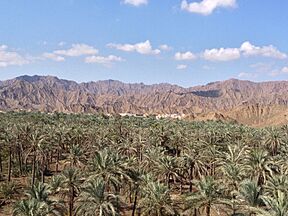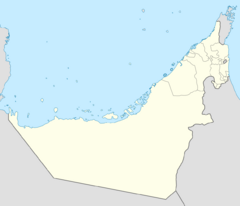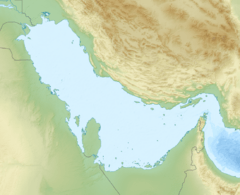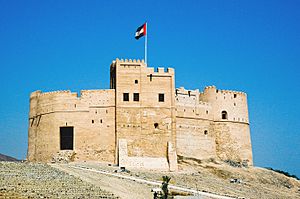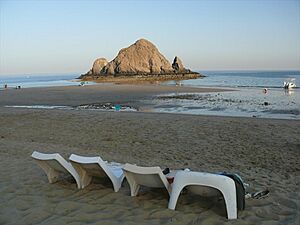Fujairah facts for kids
Quick facts for kids
Fujairah
الفجيرة
|
||
|---|---|---|
|
Clockwise from top: Date palms in Fujairah, Al Hajar Mountains, Sheikh Zayed Mosque - Fujairah, Fujairah Fort
|
||
|
||
| Country | United Arab Emirates | |
| Emirate | Fujairah | |
| Government | ||
| • Type | Monarchy | |
| Area | ||
| • Total | 46 km2 (18 sq mi) | |
| Population | ||
| • Total | 118,933 | |
| • Density | 2,586/km2 (6,700/sq mi) | |
| GDP | ||
| • Metro | US$ 6.8 billion (2023) | |
| • Per capita | US$ 23,500 (2023) | |
Fujairah City (Arabic: الفجيرة) is the capital of the Emirate of Fujairah in the United Arab Emirates. It is the seventh-largest city in the UAE. Fujairah is located on the Gulf of Oman, which is part of the Indian Ocean. It is the only capital city in the UAE found on the country's east coast. Fujairah City is a busy place for industry and trade. It sits at the base of the Al Hajar Mountains.
Contents
People and Population
In 2016, about 97,226 people lived in Fujairah City. This was a big part of the total population of the entire emirate. By 2023, the city's population grew to 118,933. Fujairah's population has been growing steadily. This is because of new businesses, city development, and more people moving there from other countries. About 30-40% of the people in Fujairah are native Emiratis.
Weather and Climate
Fujairah has a hot desert climate. This means it has very warm winters and extremely hot summers. In summer, daytime temperatures often reach about 41 °C (106 °F). Winter temperatures are milder, usually around 25 °C (77 °F). The air can feel very humid, especially in summer. This makes the heat feel even stronger. Fujairah does not get much rain. Most of the rain falls between December and March. The city gets about 120 mm (4.7 inches) of rain each year.
2022 Floods in Fujairah
In July 2022, Fujairah had major floods. Heavy rains caused a lot of damage across the emirate. Businesses and homes were affected. These floods were part of a big weather event. It brought the most rain seen in nearly 30 years. Many traders in Fujairah lost a lot of money. Hundreds of people needed to be rescued. Temporary shelters were set up for those who had to leave their homes.
| Climate data for Fujairah International Airport (1991–2020) | |||||||||||||
|---|---|---|---|---|---|---|---|---|---|---|---|---|---|
| Month | Jan | Feb | Mar | Apr | May | Jun | Jul | Aug | Sep | Oct | Nov | Dec | Year |
| Record high °C (°F) | 35.3 (95.5) |
35.6 (96.1) |
41.7 (107.1) |
44.1 (111.4) |
50.2 (122.4) |
49.5 (121.1) |
49.0 (120.2) |
48.3 (118.9) |
45.0 (113.0) |
41.5 (106.7) |
38.7 (101.7) |
32.8 (91.0) |
50.2 (122.4) |
| Mean daily maximum °C (°F) | 24.8 (76.6) |
25.9 (78.6) |
28.6 (83.5) |
33.9 (93.0) |
38.6 (101.5) |
39.3 (102.7) |
37.6 (99.7) |
36.5 (97.7) |
35.9 (96.6) |
34.2 (93.6) |
30.2 (86.4) |
26.7 (80.1) |
32.7 (90.9) |
| Daily mean °C (°F) | 20.8 (69.4) |
21.9 (71.4) |
24.3 (75.7) |
29.1 (84.4) |
33.6 (92.5) |
34.9 (94.8) |
34.1 (93.4) |
33.0 (91.4) |
32.1 (89.8) |
30.2 (86.4) |
26.2 (79.2) |
22.7 (72.9) |
28.6 (83.5) |
| Mean daily minimum °C (°F) | 17.1 (62.8) |
18.1 (64.6) |
20.5 (68.9) |
24.8 (76.6) |
29.3 (84.7) |
31.4 (88.5) |
31.6 (88.9) |
30.7 (87.3) |
29.2 (84.6) |
26.5 (79.7) |
22.5 (72.5) |
18.9 (66.0) |
25.0 (77.0) |
| Record low °C (°F) | 10.8 (51.4) |
11.0 (51.8) |
14.8 (58.6) |
17.2 (63.0) |
20.5 (68.9) |
26.4 (79.5) |
26.7 (80.1) |
26.0 (78.8) |
24.4 (75.9) |
18.5 (65.3) |
16.8 (62.2) |
10.5 (50.9) |
10.5 (50.9) |
| Average precipitation mm (inches) | 20.5 (0.81) |
10.3 (0.41) |
24.8 (0.98) |
7.6 (0.30) |
1.9 (0.07) |
0.0 (0.0) |
1.5 (0.06) |
0.2 (0.01) |
0.1 (0.00) |
5.8 (0.23) |
9.4 (0.37) |
25.0 (0.98) |
107.2 (4.22) |
| Average precipitation days (≥ 1 mm) | 2.6 | 2.4 | 2.9 | 1.7 | 1.6 | 0.0 | 1.5 | 1.0 | 1.0 | 1.7 | 1.8 | 2.5 | 21.0 |
| Source: NOAA | |||||||||||||
Business and Economy
Fujairah City is the main place for business and trade in the emirate. Tall office buildings line Hamad Bin Abdulla Road. This is the main road into the city. The road goes through the city and connects Fujairah City to Dubai. It also links to the Emirate of Sharjah.
The city's location is very important. It gives the UAE direct access to the Indian Ocean. This means ships do not have to use the Persian Gulf. Using the Persian Gulf requires passing through the Strait of Hormuz. The northern part of the waterfront has many large tanks for storing oil.
Special Economic Zones
The Fujairah Free Zone is a special area north of the city. It has different rules for businesses. Creative City is another special zone for media companies. It is on the Sheikh Khalifa Highway to the west. It started in 2007. It helps companies in media, music, entertainment, and marketing.
Port of Fujairah
The Port of Fujairah is on the city's eastern coast. It is just outside the Strait of Hormuz. The port was built in 1978 and started working in 1983. Today, its quay (the edge where ships dock) is over 6.7 km long.
The port is on a major global shipping route. It is one of the world's largest places for bunkering. Bunkering means supplying fuel to ships. Other big bunkering hubs are Singapore and Rotterdam. The port is also a major oil hub. It plans to increase its oil storage by 75% by 2022.
Fujairah Oil Industry Zone
The Fujairah Oil Industry Zone (FOIZ) is north of the Port of Fujairah. It can store 10 million cubic meters of refined oil products. It was created to manage the oil and gas industry in Fujairah. It also helps new oil businesses grow. Eighteen companies work in the FOIZ. Aramco Trading Company opened an office here in 2019. It was their second office outside Saudi Arabia.
Shopping in Fujairah
Fujairah has many shopping malls. These include the large City Centre Fujairah mall, which opened in 2012. Other popular malls are the Fujairah Mall (opened in 2016), LuLu Mall (opened in 2014), and Century Mall. For traditional shopping, you can visit the Central Market, Fabric Souk, and a Fish & Vegetable Market.
Education and Learning
The University of Fujairah is located in Fujairah City. The city also has several other universities.
Some schools in the city include Diyar Private Academy, Our Own English High School, Indian School Fujairah, and St Mary's Catholic High School.
Places to Visit
The old Fujairah Fort has been restored. The Fujairah Museum is also nearby in Fujairah City. The Fujairah Heritage Village, close to Madhab Spring Park, shows how people lived in the past. The main mosque is the huge white Sheikh Zayed Mosque. It is the second largest mosque in the UAE. You can see it from many parts of the city center. It can hold about 28,000 people praying.
The Fujairah Museum opened in 1991. It displays old items found in the emirate. Some items are from as far back as 6,000 BC. Others are from more recent Islamic times. You can see pottery, jewelry, and spearheads. The most famous item in the museum is an ostrich egg from 2,500 BC.
Along the sea, you'll find Fujairah Corniche and Fujairah International Marine Club. These are on Al Corniche Road. There is also bullfighting on Friday afternoons. To the north is Fujairah Beach on Al Faseel Road.
The bullfighting in Fujairah City is a popular public event. It is different from Spanish bullfighting. It does not involve matadors and the animals are not harmed. Two bulls lock horns and push each other. Sometimes, they can get minor injuries. Families often attend these events, but betting is not allowed.
Most major hotels are located on or near Hamad Bin Abdulla Road and Al Corniche Road.
Getting Around
The Sheikh Khalifa Bin Zayed Expressway (also called Sheikh Khalifa Highway) is a big road. It connects Fujairah City with Dubai and other parts of the UAE. It goes through the mountains near the city. This road leads into Hamad Bin Abdulla Road. This road then continues through the city to the coast.
Fujairah International Airport
The main airport in the emirate is Fujairah International Airport. It is south of Fujairah City. Currently, it mostly handles cargo flights. Pakistan International Airlines started passenger flights to Fujairah Airport on November 25, 2021. They now have two flights a week from Peshawar and Islamabad in Pakistan.
Also, EgyptAir flies to Cairo. SalamAir has regular flights to Muscat. From Muscat, you can fly to places in India and Southeast Asia. They also have seasonal flights to Salalah.
Etihad Rail
The UAE's national railway, Etihad Rail, will connect Fujairah with other emirates. This railway will help transport goods. It will also reduce traffic on roads. The railway aims to link industrial cities across the UAE. This will improve Fujairah's transportation system. It will also help the city's economy grow. The first passenger station for Etihad Rail is being built in the Sakamkam Area of Fujairah City.
See also
 In Spanish: Fuyaira (ciudad) para niños
In Spanish: Fuyaira (ciudad) para niños


